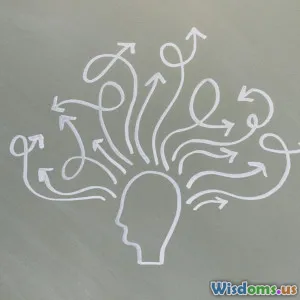
How to Train Yourself to Lucid Dream Backed by Science
10 min read Unlock the secrets of lucid dreaming with proven scientific methods to train your brain for conscious dreams. (0 Reviews)
How to Train Yourself to Lucid Dream Backed by Science
Imagine stepping into the dream world with full awareness, shaping the narrative, flying through skies, or solving personal dilemmas — all within your sleep. This phenomenon is lucid dreaming, a unique state where dreamers are conscious they are dreaming and can sometimes control their dreams. Though it might sound mystical, lucid dreaming is a real, measurable psychological state supported by neuroscience.
Introduction
Lucid dreaming has fascinated humankind for centuries, but only recently has it become approachable through scientific study. Understanding how to train yourself to lucid dream not only opens a doorway to vivid, immersive experiences but also holds promising therapeutic potential. Sleep researchers, psychologists, and neurologists have collaborated to uncover the mechanisms behind lucid dreaming and designed step-by-step protocols that anyone can follow.
In this article, you will discover essential brain science insights, evidence-based techniques, and actionable steps to awaken consciousness within your dreams.
What is Lucid Dreaming? A Neuroscientific Perspective
Lucid dreaming can be defined as a state during rapid eye movement (REM) sleep where the dreamer gains awareness that they are dreaming. This conscious insight often occurs alongside vivid dreams and varies from mere awareness to complete control over the dream narrative.
Brain Activity in Lucid Dreaming
Studies using EEG and fMRI technology reveal distinct brain activation patterns during lucid dreams:
-
Prefrontal Cortex Activation: Normally inactive or less active during REM sleep, the dorsolateral prefrontal cortex (responsible for self-awareness and executive function) becomes notably active during lucid dreams. This reactivation correlates with metacognition — the ability to think about one's own mental state.
-
Sensorimotor Cortex Engagement: Movement commands can be generated consciously, explaining why some lucid dreamers can control dream actions.
-
Gamma Waves: Elevated gamma brainwave activity (~40 Hz) during lucid dreaming correlates with higher-level cognitive functions and consciousness.
An example is the ground-breaking 2014 study by Dresler et al., where lucid dreamers signaled researchers in real-time by performing eye-movement patterns detectable on EEG. This confirmed that lucid dreamers can communicate consciously during sleep.
Science-Backed Techniques to Train Lucid Dreaming
Achieving lucid dreams consistently requires practice and employing techniques grounded in science. Below are the most validated methods along with explanations on their effectiveness.
1. Reality Testing (Reality Checks)
Method: Throughout the day, repeatedly ask yourself, "Am I dreaming?" and perform a simple test to confirm reality, such as trying to push a finger through your palm or reading text twice.
Science Behind It: This habit trains your brain to question reality consistently. Because dreams often contain inconsistencies, these frequent reality checks increase the chance that your brain will perform them during sleep, triggering lucidity.
Tips: Keep a list or reminder on your phone, or attach reality checks to daily activities like checking the time.
2. Keeping a Dream Journal
Method: Immediately upon waking, write down all remembered dream details.
Scientific Insight: Frequent dream journaling improves dream recall and heightens sleep awareness, key foundations for identifying dream signs.
For instance, a 2011 study by Schaefer & Philipp shows that dream recall improves significantly with journaling after only a week, reinforcing the connection between memory consolidation and sleep-tracking.
3. Mnemonic Induction of Lucid Dreams (MILD)
Method: Before falling asleep, consciously repeat a phrase like, "Next time I’m dreaming, I will realize I’m dreaming."
Mechanism: This uses prospective memory cues — intentions to perform an action at a future time — leveraging working memory to signal awareness in dreams.
Research by Dr. Stephen LaBerge at Stanford University demonstrated that MILD increases lucid dreaming frequency by promoting intention retention across sleep transitions.
4. Wake-Back-to-Bed (WBTB)
Method: Set an alarm to wake you after about 4.5 to 6 hours of sleep. Stay awake and engage with lucid dream induction methods (reading about dreaming, set MILD intentions), then fall back asleep.
Rationale: REM sleep periods lengthen later in the night, making lucid dreams easier to induce. WBTB increases the likelihood of entering REM while maintaining partial consciousness.
A 2017 randomized trial by Stumbrys et al. confirmed that WBTB combined with MILD significantly increased lucid dream occurrence.
5. Wake-Initiated Lucid Dreaming (WILD)
Method: Try to keep consciousness while your body falls asleep, transitioning directly into a dream with awareness.
Neural Correlate: This technique demands fine-tuning attention to sensorimotor rhythms while the cortex shifts from wakefulness to REM — a challenging but rewarding endeavor.
Practicing relaxation and hypnagogic state mindfulness enhances WILD success.
Practical Tips for Maximizing Success
-
Consistency is Crucial: Lucid dreaming is a skill where neuroplasticity and learning come into play. Practice techniques daily.
-
Sleep Hygiene: Quality sleep improves REM durations necessary for lucid dreaming. Avoid caffeine before bed, maintain a cool, dark room, and stick to regular schedules.
-
Meditation: Mindfulness meditation cultivates increased metacognitive awareness that translates well into the dream state.
-
Use Technology Cautiously: Devices like sleep masks with light cues (like the NovaDreamer) can nudge awareness but should be combined with behavioral techniques.
-
Patience: Lucid dreaming may take weeks or months of practice but yields transformative experiences, as noted by countless participants in research cohorts.
The Benefits and Applications of Lucid Dreaming
Apart from exhilarating dream control, lucid dreaming offers multiple psychological advantages:
-
Overcoming Nightmares: Lucid dreaming therapy helps PTSD victims and nightmare sufferers by transforming a fearful dream into a controllable environment.
-
Problem-Solving: Creative insights and rehearsal during lucid dreams can improve waking performance—in sports, arts, and decision-making.
-
Self-Reflection: Enhancing self-awareness has parallels with waking mindfulness, promoting emotional resilience.
Dr. Paul Tholey, a pioneer in lucid dreaming research, famously said, "Lucid dreaming is a powerful tool to explore the workings of the mind — it’s like a playground where psychology meets art."
Conclusion
Training yourself to lucid dream is no longer the stuff of folklore or fantasy — it is a reproducible, scientifically supported skill accessible to nearly everyone. By understanding the brain’s role in awareness during REM sleep and applying proven techniques like reality testing, MILD, and WBTB, you can unlock conscious dreaming and transform your nocturnal experiences.
Lucid dreaming provides not just an adventurous playground but a gateway to emotional healing, creative breakthroughs, and enriched self-awareness. Whether you want to fly through alien worlds or confront recurring nightmares, science offers a structured map to cultivate this ancient ability.
Start today by dreaming vividly, questioning your reality, and setting the intention to become lucid—your mind is ready for the journey.
References
- Dresler, M. et al. (2014). Neural correlates of dream lucidity obtained from contrasting lucid versus non-lucid REM sleep: A combined EEG/fMRI case study. Sleep, 37(5), pp. 703-709.
- LaBerge, S. (1980). Lucid Dreaming: An Exploratory Study of Consciousness During Sleep. Dreaming Journal.
- Schaefer, K., & Philipp, M. (2011). Dream Recall and Dream Content during Dreams of High and Low Dream Recallers. International Journal of Dream Research.
- Stumbrys, T., Erlacher, D., & Schredl, M. (2017). Testing the Wake-Back-to-Bed Method in an Online Dream Study. Journal of Sleep Research.
- Tholey, P. (1983). Pathologie, Therapie und Technik des luziden Träumens. Deutsche Medizinische Wochenschrift.
Rate the Post
User Reviews
Popular Posts


















